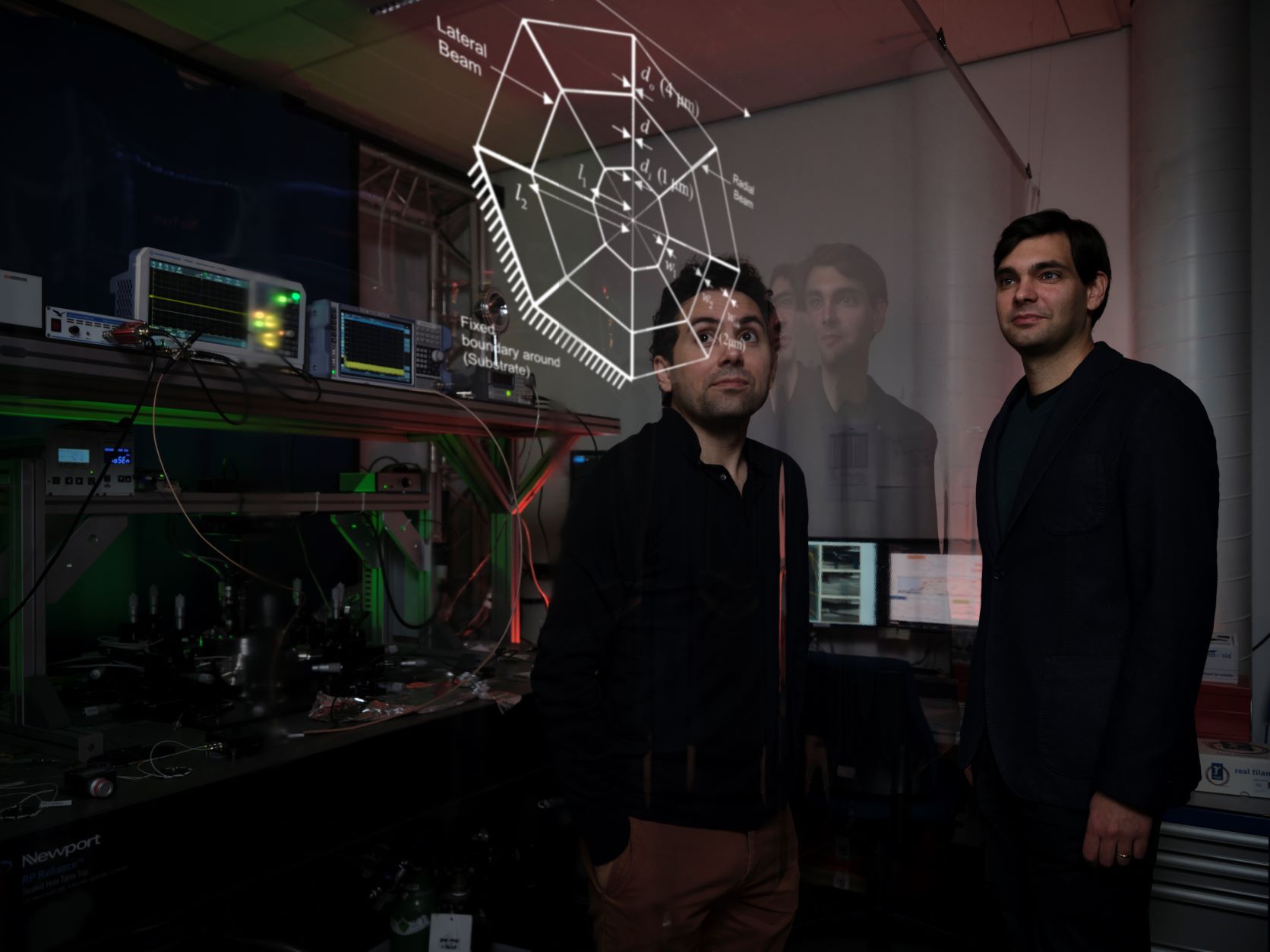Inspired by spiderwebs, researchers have designed the Holy Grail for quantum technology that works at room temperature. “We hitchhiked on millions of years of evolution.”
Richard Norte (left) and Miguel Bessa (right) demonstrate a new type of sensor in the lab. (Photo: Frank Auperlé)
What do a spiderweb and one of the newest sensors developed at TU Delft have in common? They both cancel out external noise. Spiderwebs are great vibration detectors, allowing spiders to sense vibrations inside the web (so they can find their prey), but not outside it, like wind through trees. Likewise a new TU Delft sensor cancels out all energy from outside. And this is no coincidence. Richard Norte (3mE Faculty) and Miguel Bessa (EEMCS Faculty), who led the research, were inspired by arthropod artwork.
The sensor, which measures a couple of square millimetres, but which is only 50 nanometres thick (and thus invisible to the naked eye), could help the study of gravity and dark matter, and have implications for the field of the quantum internet. Or so the researchers write in an article published last week in the journal Advanced Materials’ Rising Stars Issue. Importantly, the device also functions at room temperature.
Why is that so special? One of the biggest challenges in studying vibrating objects at the smallest scale, such as forces caused by gravity or dark matter, is preventing ambient thermal noise from bulldozing everything. Quantum hardware, for example, is usually kept at near absolute zero (−273.15°C) temperatures, with refrigerators costing half a million euros apiece.
“The problem with room temperature,” said Norte, “is that you have all these atoms and molecules jiggling around, creating noise and vibration. They can drown out the fragile quantum states and dominate the subtle forces you might want to measure, for instance those caused by gravity or dark matter. But our sensor shields off most of this outside noise.”
‘We decided to let AI guide the discovery process’
Other researchers went there before them, but their structures were more complicated. The TU Delft design is simpler and the researchers have spiders and machine learning to thank for that. And, well, corona too.
“I’ve been doing this work on sensors now for a decade when, during lockdown, I noticed a lot of spiderwebs on my terrace,” said Norte. “I realised that these structures are designed to be most sensitive to vibrations emanating from the web and not from surrounding environmental vibrational disturbances. So why not hitchhike on millions of years of evolution and use a spiderweb as an initial model for an ultra-sensitive device?”
Spiderwebs have millions of different configurations. “We couldn’t test all of them to find out which works best,” said Bessa, a machine learning expert, “so we decided to let AI guide the discovery process.” To the researchers’ surprise, the algorithm proposed a relatively simple spiderweb which consists of only six strings put together deceptively simply. Norte describes the web as looking “quite cartoonish. Like a web you would draw for Halloween.”
Swing on for nearly a century without stopping
Based on this new design, co-first author Andrea Cupertino built a microchip sensor with an ultra-thin, nanometre-thick film of ceramic material called Silicon Nitride. They tested the model by forcefully vibrating the microchip ‘web’ and measuring the time it took for the vibrations to stop. The result was impressive. “We found almost no energy loss outside our microchip web,” said Norte. “The vibrations move in a circle on the inside and don’t touch the outside. This is somewhat like giving someone a single push on a swing, and having them swing on for nearly a century without stopping.”
Do you have a question or comment about this article?
tomas.vandijk@tudelft.nl


Comments are closed.